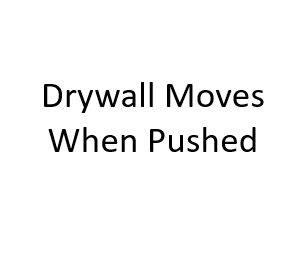Drywall, a common building material used in interior construction, is known for its durability and versatility. However, it’s not uncommon to notice that drywall can move when pushed, which can be a cause for concern. In this blog post, we will explore the reasons and will try to find the answer that why drywall moves when pushed?
Drywall Basics
Before we delve into the reasons why drywall moves when pushed, let’s understand some basics about this material. Drywall, also known as gypsum board or plasterboard, consists of a core made from gypsum sandwiched between two layers of paper. It is widely used for creating interior walls and ceilings due to its cost-effectiveness and ease of installation.
Moisture and Humidity
One of the primary reasons why drywall can move when pushed is its sensitivity to moisture and humidity. Gypsum, the core component of drywall, is hygroscopic, meaning it readily absorbs and releases moisture. When exposed to high humidity levels, drywall can absorb moisture from the air, causing it to swell and expand. Conversely, in dry conditions, it can release moisture and contract.
Solution: To prevent drywall movement due to moisture, it’s crucial to maintain consistent indoor humidity levels. Using dehumidifiers or humidifiers as needed can help regulate humidity within the recommended range of 30-50%.
Improper Installation
Another common cause of drywall movement is improper installation. When drywall panels are not securely fastened to the wall studs or ceiling joists, they can become loose over time. This can lead to a noticeable wobbling or movement when pushed or bumped.
Solution: To address this issue, ensure that drywall is properly installed by experienced professionals. Use the appropriate screws or nails to secure the panels to the framing members, following the manufacturer’s guidelines.
Settlement and Foundation Issues
Structural settlement or foundation problems in a building can also contribute to drywall movement. When the foundation settles unevenly or experiences shifting, it can cause the walls and ceilings to move, leading to cracks and gaps in the drywall.
Solution: If you suspect settlement or foundation issues, it’s essential to consult with a structural engineer or a foundation specialist. They can assess the situation and recommend necessary repairs to stabilize the building.
Temperature Fluctuations
Extreme temperature fluctuations can affect drywall. When exposed to frequent temperature changes, drywall can expand and contract, leading to movement and potential cracks.
Solution: Proper insulation and climate control within your home or building can help mitigate the effects of temperature fluctuations on drywall. Insulating exterior walls and using energy-efficient windows and doors can help maintain a stable indoor temperature.
Natural Settling of New Construction
In newly constructed buildings, it’s not uncommon for drywall to experience some settling as the structure adjusts to its new environment. This settling can result in minor cracks and slight movements.
Solution: Allow new constructions to settle naturally, and monitor any changes in drywall. If excessive movement or cracking occurs, consult with builders or contractors to assess and address the issue.
Wall Framing Issues
Sometimes, drywall movement can be attributed to problems with the wall framing itself. If the studs or joists are not properly aligned or are spaced too far apart, it can lead to inadequate support for the drywall. This lack of structural support can result in noticeable movement when pressure is applied to the wall.
Solution: If you suspect framing issues, consult with a contractor or structural engineer. They can evaluate the framing and make any necessary adjustments or reinforcements to ensure proper support for the drywall.
Heavy Objects and Wall Anchors
Hanging heavy objects on your drywall without using the appropriate anchors or supports can also cause movement and damage. Over time, the weight of these objects can pull on the drywall, leading to sagging or visible gaps.
Solution: When hanging heavy items like mirrors, shelves, or artwork, use wall anchors or brackets designed to distribute the weight evenly. Be mindful of the recommended weight limits for your wall anchors and choose the appropriate ones for your needs.
Age and Wear
As with any building material, drywall can age and deteriorate over time. This natural aging process can lead to a decrease in its structural integrity, making it more susceptible to movement and damage.
Solution: Regularly inspect your drywall for signs of wear, such as cracks, dents, or sagging. Address any issues promptly, either through repairs or by replacing damaged sections of drywall.
Proper Maintenance
Maintaining your drywall is crucial to preventing movement and preserving its appearance. Routine maintenance includes patching up small cracks or holes, repainting when necessary, and addressing any issues as they arise.
Solution: Make a maintenance schedule for your drywall, and perform inspections periodically. By addressing minor problems early, you can prevent them from escalating into more significant issues.
Conclusion
Understanding the reasons behind why drywall moves when pushed and implementing the appropriate solutions is essential for maintaining the integrity and aesthetics of your interior walls and ceilings. Whether it’s addressing moisture and humidity, ensuring proper installation, or dealing with other structural factors, taking proactive steps can help you enjoy long-lasting and stable drywall surfaces in your home or building. Remember that regular maintenance and timely repairs play a crucial role in preserving the quality of your drywall over time.
